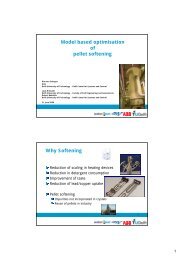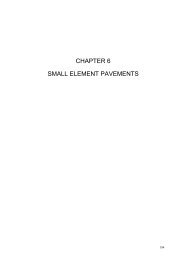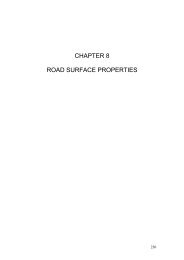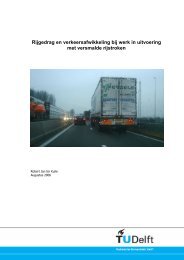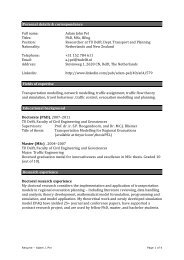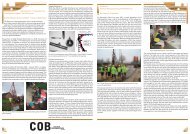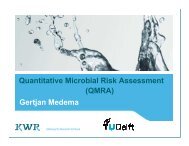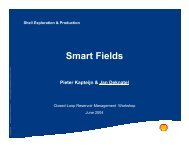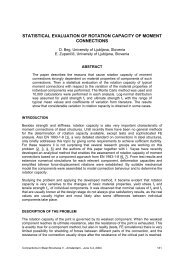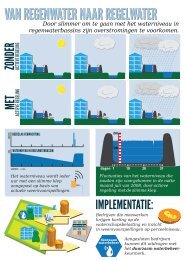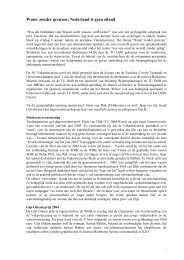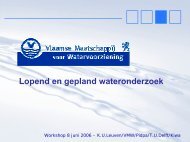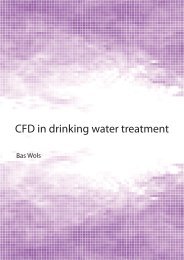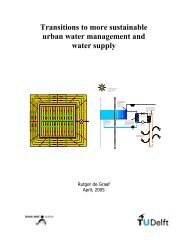Pedestrian route-choice and activity scheduling theory and models
Pedestrian route-choice and activity scheduling theory and models
Pedestrian route-choice and activity scheduling theory and models
Create successful ePaper yourself
Turn your PDF publications into a flip-book with our unique Google optimized e-Paper software.
S.P. Hoogendoorn, P.H.L. Bovy / Transportation Research Part B 38 (2004) 169–190 183<br />
<strong>route</strong>s that all lead to the escalator E6. In this case, combined <strong>route</strong>-<strong>choice</strong>/<strong>activity</strong> area <strong>choice</strong><br />
yield different <strong>route</strong>s but the same <strong>activity</strong> area. Fig. 2b shows three exemplar <strong>route</strong>s leading to the<br />
exits. Not all <strong>route</strong>s lead to the same exit in this case.<br />
5.6. <strong>Pedestrian</strong> <strong>route</strong> <strong>choice</strong> <strong>and</strong> <strong>activity</strong> area <strong>choice</strong> for congested operations<br />
Section 5.5 showed how we can determine the optimal walking paths for pedestrians under the<br />
assumption that pedestrian flow conditions are time-independent (<strong>and</strong> no time restrictions apply).<br />
However, in practice pedestrian traffic conditions will deteriorate due to other pedestrians walking<br />
in the same area. This deterioration will restrict the maximum speed v 0 ðt; xÞ at which pedestrians<br />
can walk, <strong>and</strong> increase the discomfort experienced in crowded areas. <strong>Pedestrian</strong>s will reconsider<br />
the former <strong>route</strong> <strong>choice</strong> by including the additional delays due to the prevailing congestion into<br />
their path <strong>choice</strong>. To include prevailing <strong>and</strong> future conditions in the pedestrian pathfinding behavior,<br />
two options are considered in the ensuing:<br />
1. <strong>Pedestrian</strong>s consider instantaneous information regarding prevailing conditions.<br />
2. <strong>Pedestrian</strong>s anticipate on future conditions, by incorporating the anticipated behavior of<br />
other pedestrians <strong>and</strong> the resulting expected future traffic conditions.<br />
In the remainder of this article, the case where pedestrians react on current flow conditions is<br />
considered. Anticipation on future conditions involves using predictions of the pedestrian traffic<br />
conditions in the walking infrastructure, which can be achieved by simultaneously solving the<br />
HJB equation (24) <strong>and</strong> a dynamic model describing pedestrian traffic conditions (Hoogendoorn,<br />
2001).<br />
To include the reaction to current traffic conditions, average walking speeds vðt; xÞ are determined<br />
based on the average speeds of the pedestrians in the microscopic simulation model<br />
(Hoogendoorn, 2001), or any other model describing pedestrian flow operations. These speeds are<br />
subsequently used to restrict the speeds according to<br />
v 0 ðt; xÞ ¼vðt; xÞ<br />
ð35Þ<br />
Secondly, the L 4 ðt; x; vÞ ¼cðt; xÞ is updated to include the current traffic conditions in the<br />
running cost function L. Generally, it will suffice to determine the average traffic concentration<br />
kðt; xÞ, <strong>and</strong> use rðt; xÞ ¼cðkðt; xÞÞ. Having updated both the maximum speed <strong>and</strong> the interaction<br />
cost, we can again solve the HJB equation numerically. We hypothesize that pedestrians will not<br />
continuously reconsider their <strong>route</strong>-<strong>choice</strong>, but only at discrete time intervals, say at each 10s.<br />
Example 2 (Route <strong>choice</strong> for congested conditions). Fig. 3 shows the case where pedestrians enter<br />
at x 1 ¼ 0 <strong>and</strong> walk towards the destination at x 1 ¼ 40 m <strong>and</strong> 17:5 m6 x 2 6 22:5 m. We assume<br />
that the speed is constant (1.5 m/s). According to the optimal control law, pedestrians walk in the<br />
direction perpendicular to the iso-cost curves. Fig. 3a shows the minimal <strong>route</strong> costs W ðt; xÞ <strong>and</strong> the<br />
resulting <strong>route</strong> <strong>choice</strong> for free-flow conditions. Fig. 3b shows the optimal cost function W ðt; xÞ,<br />
when the reduction in speed caused by congestion is taken into account. Clearly, pedestrians are<br />
inclined to change their <strong>route</strong> to avoid the congestion.



